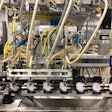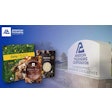They happen to relate to human food and not to petfoods, but we thought we should show you these examples of novel packs from a Food Packaging Design Awards competition organized by packaging-board company Stora Enso of Finland in conjunction with Helsinki's University of Art and Design.
Mobile Meals had been chosen as the competition theme, to lead the search for new packaging designs that suit today's take-away food culture in the towns and cities of the western world. Young designers were invited to identify fresh applications for paperboard in pack types for eat-on-the-go food.
Winning entry was the salad carton shown here. It was praised by the jury as updating the traditional carton into a form that is spacious, yet compact and simple to use. The take-away snack plate pictured won second prize for being a remarkably simple concept in which a clear, functional shape combines with an efficient locking mechanism.
Own-brand bird pellets have a label makeover
A key area of business for UK-based Unipet International Ltd is the production of wild bird feeds, which are manufactured in pellet form in a range of flavors that includes beef suet, wild berry, and insect! Typically they are supplied in 500-g pouch packs, labeled with customer brands and supplied to both independent and grocery channels.
Until recently, these packs were labeled by hand even though they had been filled and packed automatically. So the process was labor intensive and time consuming. This is now history, however, because the factory has integrated a semi-automatic labeling system into the existing packaging line.
Details provided by Precision Applications Ltd for the use of its PA10E system in this British factory, say that Unipet normally uses 110-mm2 labels on which are pre-printed the customer brand, product information and weight. Labels are applied automatically to each pouch pack while it is flat.
The process remains semi-automatic in order to retain some degree of operator control, according to Unipet director Andrew Ball. Labeling can be operated by all members of staff with only a basic amount of training needed. A changeover of labels from one brand to another is completed within 15 minutes.
Being able to achieve fast turn-around times is increasingly important, to judge from other comments by Andrew Ball. He noted a trend away from long production runs of standard items to much shorter runs of specialized branded goods.












